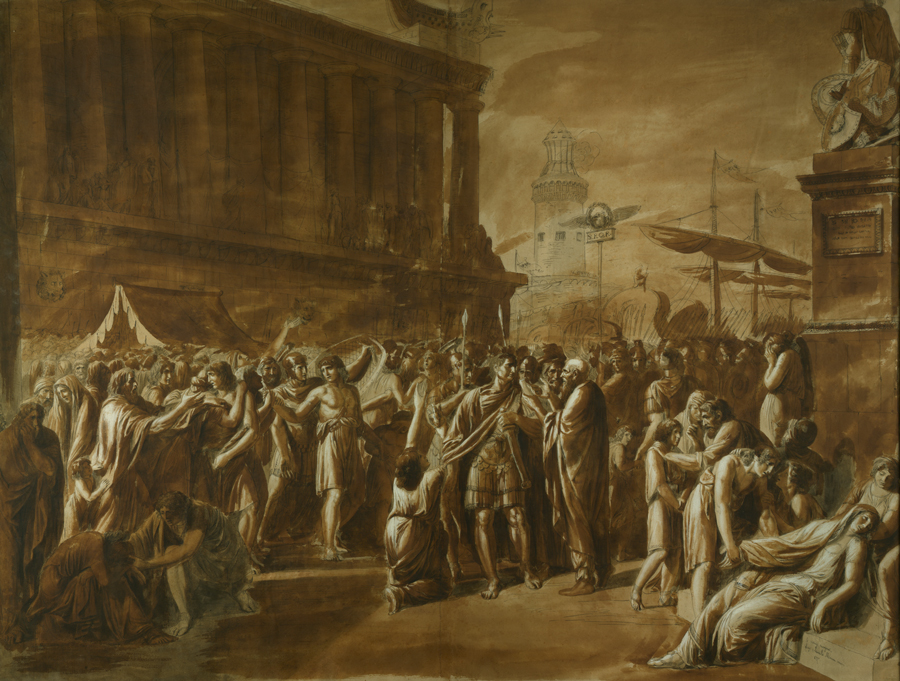Loading the page ...
Luigi Ademollo
(1764 Milan – 1849 Florence)
"Gli ostaggi cartaginesi" (The Embarkation of the Carthaginian Hostages led by Marcus Attilius Regulus). Pen and greyish-brown ink over pencil, point of the brush and several shades of brown wash, heightened with white. 94 x 123 cm. Signed and dated: Luigi Ademollo Milanese inven. 1790.
This tour de force by Luigi Ademollo significantly bears the date 1790. The previous year the Bastille in Paris had been stormed, sending the Ancien Regime hurtling towards its bloody apotheosis. The artistic attitude emanated by this work of the young Ademollo is appropriately heaven-storming and redolent of revolutionary spirit. The truly monumental format of the drawing and the ingeniously arranged composition, enlivened by numerous staffage figures, provide striking proof of the grinta, the bold self-confidence of the up-and-coming artist. The previous year Ademollo had won the competition for the decoration of the Teatro alla Pergola in Florence. It is as though he wanted to use this ambitious crowd scene to give another demonstration of his skill. In any case the imposing format of the drawing could be an indication that it was intended as a design or presentation drawing for a monumental painting.
Given the date of the drawing, it is not surprising that Ademollo was interested in this theme from the days of the Roman Republic. The dramatic story of the Roman consul, Marcus Attilius Regulus, was considered a classic example of stoic virtue and was in keeping with the revolutionary ideals of the last decade of the 18th century. In the First Punic War Regulus had initially dealt the Carthaginians a crushing defeat before himself being beaten by them in 255 B.C.and taken prisoner. He was sent as an envoy to Rome to engage in peace talks, provided he returned if the negotiations fell through. Once in Rome he selflessly called upon the Senate to continue the war and returned to Carthage, where he was tortured to death. The story of Regulus was celebrated by several Roman authors, including Horace, Cicero and Livy, the consul being considered the ideal embodiment of classical Roman virtue, as he had placed the interests of his country over his personal welfare.
Ademollo has taken full advantage of the dramatic potential of his heroic theme, paying great attention to the rendering of human emotions. The place is the port of Ostia, where the consul and his Roman legionaries are taking leave of their families before setting off on their journey back into captivity. The main protagonist, Attilius Regulus, is standing somewhat right of centre, addressing some final words to a senator, while a young woman has thrown herself, wailing, at his feet. It is a bustling, noisy and jostling scene that Ademollo shows us. Women are giving the hostages a farewell embrace or lying prostrate with grief, while the men conduct themselves more and look on in silence. Countless onlookers observe the turbulent proceedings from the lofty vantage point of the temple in the background. In the vast, anonymous crowd Ademollo has picked out particular faces and given them individual characteristics. These faces show a wide variety of emotions, ranging from despair to silent resignation. Our sympathy is particularly aroused by a scene in the right foreground, where a young Roman girl, overcome by grief, has collapsed at the foot of a victory monument adorned with trophies. A young man bends over her solicitously, while a bearded old man with raised finger explains the moral of the story to a boy.
The daring composition betrays Ademollo’s training as a stage-designer. The obliquely receding temple architecture conveys an awesome sense of space. Great attention has also been paid to the archaeological details, which are intended to lend historical authenticity to the scene. The broad and sweeping use of wash produces dramatic chiaroscuro effects. While the silhouette of the colossal temple rises sombrely in the background, the crowd in the foreground is illuminated by a restlessly flickering light that intensifies the drama of the proceedings. The artistic intensity of the drawing and its unusually large format give the work a special place within the artist’s œuvre. Ademollo also executed an aquatint etching on the same theme, Meyer, Allgem. Künstler-Lexikon, vol. I, 81, 2.
